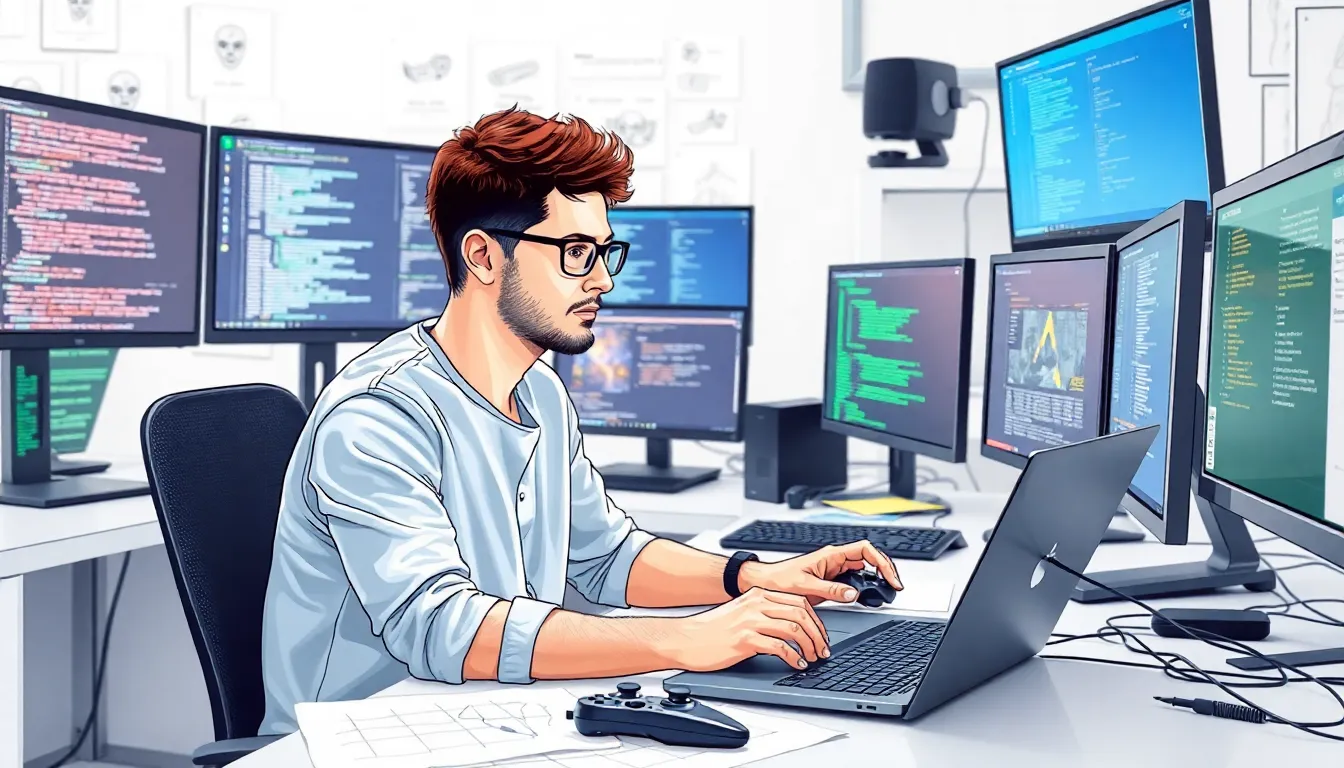Coding a game in C++ might sound like a daunting quest, but fear not! With a sprinkle of creativity and a dash of determination, anyone can transform lines of code into an epic adventure. Imagine crafting your own virtual world where players can battle dragons, solve mysteries, or simply enjoy a leisurely stroll through pixelated landscapes.
Table of Contents
ToggleUnderstanding Game Development
Game development encompasses the process of creating engaging video games that players enjoy. It involves several stages, including planning, designing, coding, and testing. Developers draft concepts that set the foundation for gameplay mechanics and visual style.
Programming languages like C++ play a vital role in this process. C++ enables developers to create efficient game engines that run smoothly on various platforms. Knowledge of data structures and algorithms improves game performance and user experience.
Art assets, sounds, and animations enhance the overall game appeal. Designers collaborate to develop visually stunning and interactive elements. Incorporating sound effects and music adds depth to the gameplay, immersing players in the experience.
Game engines streamline the development process. Popular engines, such as Unreal Engine and Unity, offer tools and resources to facilitate coding, designing, and debugging. Each engine has its advantages, so developers choose based on project requirements and personal preferences.
Collaborating within a team often leads to greater creativity and productivity. Artists, programmers, and writers blend their expertise to craft cohesive and captivating games. Feedback loops and playtesting play a crucial role in refining the game and addressing issues before launch.
Understanding the target audience informs decisions throughout development. It helps creators tailor gameplay experiences to meet player expectations, preferences, and behavior. Engaging with communities provides insights and ideas that can enhance the game design.
Exploring game development opens avenues for innovation and creativity. The combination of technology and artistry fosters unique digital experiences that resonate with players. Following established practices and continually learning ensures successful game development in C++.
Getting Started with C++

Aspiring game developers need a solid foundation in C++. Setting up the development environment and grasping basic concepts becomes essential in this journey.
Setting Up Your Development Environment
To start, select a suitable Integrated Development Environment (IDE). Popular choices include Visual Studio, Code::Blocks, and CLion. Each IDE provides essential features like code debugging and syntax highlighting. Follow the official installation guide for your chosen IDE to ensure a smooth setup. After installation, create a new project specific to your game. Configuring settings like compiler paths and project templates sets the stage for effective development. Familiarity with build processes in your IDE streamlines future projects.
Learning the Basics of C++
Understanding fundamental C++ concepts accelerates the learning curve. Begin with variable types, control structures, and functions. Each variable type serves specific data storage needs, influencing game performance. Control structures like loops and conditionals dictate game flow, impacting player experience. Functions modularize code, making it more manageable and reusable. Explore object-oriented programming principles next. Classes and objects represent game entities, enhancing organization and efficiency. Resources such as online tutorials and coding exercises provide invaluable support in this foundational phase.
Designing Your Game Concept
Designing a game concept starts with solid planning. Clarity and documentation streamline the development process.
Creating a Game Design Document
A Game Design Document (GDD) outlines the game’s vision and serves as a blueprint for the project. Including key elements such as game genre, target audience, and platform establishes direction. A thorough GDD covers features, levels, characters, and narrative elements. Grabbing attention through visualizations and diagrams makes concepts easier to understand. Updating the GDD regularly ensures that it remains relevant as development progresses.
Defining Game Mechanics and Rules
Game mechanics define how players interact with the game. Establishing core mechanics like movement, scoring, and combat shapes gameplay experiences. Balancing game rules fosters fairness and keeps engagement high. Rules should encourage player exploration while providing challenges. Integrating mechanics with the game narrative enhances immersion. Iterating on mechanics through playtesting refines the experience, ensuring it meets player expectations.
Coding Your Game
Coding a game in C++ demands a well-organized approach. Clarity in code structure streamlines development and simplifies debugging.
Structuring Your Game Code
Structuring game code involves creating modular components. Each module should focus on specific functionalities, enhancing readability and maintainability. Functions and classes represent key game elements such as player actions and enemy behaviors. Organized files, including headers and source files, facilitate efficient access and modification. Implementing naming conventions promotes consistency, making it easier for team members to understand each other’s code. Utilization of comments clarifies complicated sections, guiding future developers through the code’s logic. Following these practices lays a solid foundation for expansion and complexity as the game evolves.
Implementing Game Logic and Mechanics
Implementing game logic directly influences player experience. Decision trees can create responsive gameplay by guiding NPC behaviors based on player actions. Events triggered by player interactions add depth and excitement, keeping players engaged. Collision detection is vital for interactions between characters and obstacles, enhancing realism. Game mechanics such as scoring systems and health management reinforce objectives and challenges. Testing these elements ensures a balanced experience, rewarding players for skill while preventing frustration. Refinement through iterative playtesting leads to a polished game.
Adding Graphics and Sound
Adding graphics and sound is essential for immersing players in the game world. Integrated development environments can assist in importing assets like sprites, textures, and 3D models. Utilizing libraries such as SDL or SFML simplifies graphics rendering. Sound effects and music elevate emotional engagement, and implementing audio libraries allows for dynamic sound management. Mixing various audio cues creates an immersive environment, enriching player interactions. Careful optimization of assets ensures smooth performance across different systems. Prioritizing these aspects results in a captivating and memorable gaming experience.
Testing and Debugging Your Game
Testing and debugging play crucial roles in game development. They ensure her game runs smoothly and provides a satisfying player experience.
Identifying Common Errors
Errors often arise during coding. Debugging tools help pinpoint issues quickly, enabling developers to address them efficiently. Common errors include syntax mistakes, logic errors, and resource loading failures. Using debugging techniques such as breakpoints and step-through debugging allows for a systematic examination of code execution. Developers should also utilize compiler warnings as they often indicate potential problems early in the development process. Error logs can provide critical insights into runtime issues, further aiding debugging efforts.
Testing for Player Experience
Player experience significantly impacts a game’s success. Conducting playtests with real players offers invaluable feedback on gameplay mechanics and user interface design. Observing players helps identify frustration points and areas lacking clarity. Adjustments made based on player behavior can enhance the overall experience. Developers should employ both formal testing with structured feedback forms and informal testing with casual play to gather diverse insights. Aim for a wide range of feedback to create an engaging and enjoyable game, ensuring that it meets player expectations and encourages continued interaction.
Embarking on the journey of coding a game in C++ opens up a world of creativity and innovation. By mastering the language and understanding game design principles, developers can create immersive experiences that captivate players. The blend of coding skills with artistic elements like graphics and sound enhances the overall gameplay.
As they navigate through the stages of development from planning to testing, aspiring developers should remember the importance of collaboration and player feedback. Continuous learning and refining their skills will lead to better game performance and player satisfaction. With dedication and the right resources, anyone can turn their game ideas into reality.




